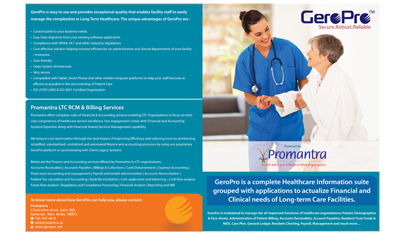Understanding the Biggest Payers in Long-Term Care

In the world of long-term care (LTC), financial stability doesn't just come from high occupancy or excellent care delivery. It hinges on one critical factor: payers. Skilled Nursing Facilities (SNFs) and Assisted Living Facilities (ALFs) operate within one of the most complex revenue cycle management ecosystems in healthcare, where multiple payer sources---each with its own rules, processes, and challenges---determine whether revenue flows smoothly or stalls in endless denials and delays.
For administrators, understanding the biggest payers in long-term care and how to manage them effectively is no longer optional; it's a survival strategy in the healthcare revenue cycle.
The Biggest Payers in Long-Term Care
1. Medicare
Medicare is often the most visible payer for SNFs, covering short-term stays after hospitalization under Part A and some outpatient services under Part B. While Medicare can be a reliable source of revenue, its requirements for documentation, length of stay, and skilled need are strict. A single oversight in eligibility or medical necessity documentation can mean denied claims or clawbacks, highlighting the importance of efficient claims processing and denial management.
2. Medicaid
Medicaid is the backbone of long-term care financing, accounting for over 50% of nursing home revenue in the U.S. However, each state runs its own Medicaid program, making billing rules, rates, and coverage highly variable. SNFs often struggle with low reimbursement rates and the complexity of state-specific requirements, emphasizing the need for robust revenue cycle management practices.
3. Managed Care Plans (Medicare Advantage and Medicaid Managed Care)
The rise of managed care has added another layer of complexity to the healthcare revenue cycle. Plans from insurers like UnitedHealthcare, Molina, BCBS, and Magellan often demand prior authorizations, require ongoing utilization reviews, and use different claim submission formats. These plans are growing rapidly---over 51% of Medicare beneficiaries are now enrolled in Medicare Advantage (KFF, 2024)---making managed care expertise critical for effective billing and coding.
4. Private Pay
While private pay residents represent a smaller portion of payer mix, they are vital for facilities because reimbursement is typically higher than government programs. However, private pay also requires diligent patient billing, transparent communication, and careful patient collections to maintain trust and ensure a smooth revenue cycle workflow.
5. Other Commercial Payers
Employers, supplemental insurers, and specialty programs occasionally cover long-term care costs. Each adds to the variety of billing requirements administrators must juggle, further complicating the revenue cycle operations.
The Challenge: One Size Doesn't Fit All
Each payer comes with its own rules, submission portals, file formats, and timelines. That means SNFs and ALFs often need separate workflows for each payer type. Without strong revenue cycle management systems in place, facilities face:
- High claim denial rates due to missing authorizations or documentation.
- Delayed reimbursements from payer backlogs or incorrect submissions.
- Revenue leakage when ancillary services (like therapy, utilities, cable, or internet) are overlooked.
- Administrative burden on staff already stretched thin.
This complexity is why so many facilities struggle with cash flow---even when census remains steady. Effective healthcare billing practices and streamlined revenue cycle departments are crucial for financial stability.
How LTCPro Helps You Manage the Payer Mix
At LTCPro, we recognize that success in long-term care isn't about working harder; it's about working smarter with payers. Our revenue cycle outsourcing and back-office solutions are designed to take the complexity out of multi-payer billing and collections so your facility can focus on what it does best---caring for residents.
Here's how our RCM services help:
1. Multi-Payer Billing Expertise
Our billing teams handle claims across all major payers---Medicaid, Medicare, BCBS, Molina, UHC, Magellan---using both automated 837 file submissions and manual portal entries where required. This ensures compliance and reduces payer-specific errors, improving overall billing accuracy and clean claims rates.
2. Eligibility and Authorization Verification
Before a single bill goes out, we run comprehensive insurance verification and financial clearance checks to confirm coverage and secure authorizations, dramatically reducing denial rates and compliance risks.
3. End-to-End AR Management
Our dedicated accounts receivable specialists track claim statuses, perform claims follow-up with payers, and resolve denials quickly. This proactive approach slashes accounts receivable days and accelerates reimbursements, improving overall revenue cycle efficiency.
4. Private Pay Support
LTCPro ensures timely, accurate patient billing and statement processing each month, supporting transparency and building trust with families. Our patient payment collection strategies help maintain a healthy cash flow from private pay sources.
5. Detailed Reporting
Month-end reconciliation and reporting give administrators a clear view of payer performance, outstanding issues, and cash flow trends---turning billing into a strategic advantage for healthcare finances.
Real-World Impact
A facility in the Midwest partnered with LTCPro after struggling with Medicaid denials and slow collections from managed care plans. Within 6 months of implementing our revenue cycle management solutions:
- Accounts receivable days dropped from 70 to 44 days.
- Claim denials fell by 35%.
- Their Medicaid reimbursement rate improved through better pre-billing compliance and faster follow-up.
This not only stabilized cash flow but also gave the facility leadership more breathing room to focus on staffing and quality care. The improvements in revenue cycle performance directly contributed to the facility's financial health.
The Bottom Line
In long-term care, your payer mix is your lifeline. But managing it doesn't have to overwhelm your facility. With a specialized revenue cycle management partner like LTCPro, SNFs and ALFs can turn payer complexity into a competitive advantage---capturing every dollar, reducing denials, and ensuring that care, not collections, remains the top priority.
Our comprehensive RCM services, including advanced billing software and revenue cycle automation tools, streamline the entire process from patient registration to payment posting. By leveraging our expertise in medical coding, electronic claims submission, and accounts receivable follow-up, facilities can significantly improve their revenue cycle operations.
LTCPro helps you master the healthcare revenue cycle so your residents and your facility thrive.
A perfect fit for Skilled Nursing Facilities, Assisted Living Facilities, Home Health, Hospice and Other Day Care Centres.
Download BrochureRequest a demo


























